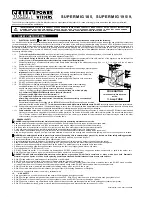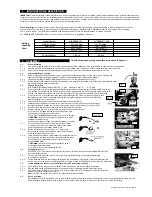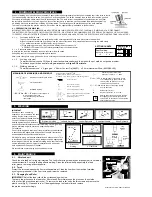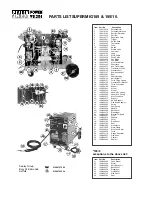
Thank you for purchasing a Sealey Welder. Manufactured to a high standard this product will, if used according to these instructions and properly maintained,
give you years of trouble free performance.
S U P E R M I G 1 8 5 , S U P E R M I G 1 9 5 / 9 ,
IMPORTANT
:
BEFORE USING THIS PRODUCT, PLEASE READ THE INSTRUCTIONS CAREFULLY. MAKE CAREFUL NOTE OF SAFETY INSTRUCTIONS,
WARNINGS AND CAUTIONS. THIS PRODUCT SHOULD ONLY BE USED FOR ITS INTENDED PURPOSE. FAILURE TO DO SO MAY CAUSE DAMAGE
OR PERSONAL INJURY, AND WILL INVALIDATE THE WARRANTY. RETAIN THESE INSTRUCTIONS FOR FUTURE USE.
1. SAFETY INSTRUCTIONS
1.1.
ELECTRICAL SAFETY.
p
p
p
WARNING! It is the users responsibility to read, understand and comply with the following:
You must check all electrical equipment and appliances to ensure they are safe before using. You must inspect power supply leads, plugs and all electrical connections
for wear and damage. You must ensure the risk of electric shock is minimised by the installation of appropriate safety devices. An RCCB (Residual Current Circuit
Breaker) should be incorporated in the main distribution board. We also recommend that an RCD (Residual Current Device) is used with all electrical products. It is
particularly important to use an RCD together with portable products that are plugged into an electrical supply not protected by an RCCB. If in doubt consult a
professional electrician. You may obtain a Residual Current Device by contacting your Sealey dealer.
You must
also read and understand the following instructions
concerning electrical safety.
1.1.1.
The
Electricity At Work Act 1989
requires all portable electrical appliances, if used on a business premises, to be tested by a qualified
Electrician at least once a year by using a Portable Appliance Tester (PAT).
1.1.2.
The
Health & Safety at Work Act 1974
makes owners of electrical appliances responsible for the safe condition of the appliance, and the safety of the
appliance operator.
If in any doubt about electrical safety, contact a qualified electrician.
1.1.3.
Ensure the insulation on all cables and the product itself is safe before connecting to the mains power supply. See 1.1.1. & 1.1.2. above and use a Portable
appliance Tester (PAT).
1.1.4.
Ensure that cables are always protected against short circuit and overload.
1.1.5.
Regularly inspect power supply, leads, plugs and all electrical connections for wear and damage, especially power
connections, to ensure that none are loose.
1.1.6.
Important:
Ensure the voltage marked on the product is the same as the electrical power supply to be used,
and check that plugs are fitted with the correct capacity fuse. A 13Amp plug may require a fuse smaller than
13Amps for certain products (
subject to 1.1.10. below)
see fuse rating at right.
1.1.7.
DO NOT pull or carry the powered appliance by its power supply lead. Products such as welders
must not be pulled or carried by their output cables.
1.1.8.
DO NOT pull power plugs from sockets by the power cable.
1.1.9.
DO NOT use worn or damage leads, plugs or connections. Immediately replace or have repaired by
a qualified Electrician. A U.K. 3 pin plug with ASTA/BS approval is fitted. In case of damage, cut off
and fit a new plug according to the following instructions (discard old plug safely).
(UK only - see diagram at right).
Ensure the unit is correctly earthed via a three-pin plug.
a) Connect the GREEN/YELLOW earth wire to the earth terminal E.
b) Connect the BROWN live wire to live terminal L.
c) Connect the BLUE neutral wire to the neutral terminal N.
After wiring, check there are no bare wires, that all wires have been correctly connected and
that the wire restraint is tight.
Double insulated products are often fitted with live (BROWN) and neutral (BLUE) wires only. Double insulated
products are marked with this symbol .
To re-wire, connect the brown & blue wires as indicated above. DO NOT
connect the brown or blue to the earth terminal.
1.1.10. Some products require more than a 13Amp electrical supply. In such a case,
NO
plug will be fitted.
You must
contact a qualified Electrician to ensure a 30 amp fused
supply is available. We recommend you discuss the installation of a industrial round pin plug & socket with your electrician.
1.1.11.
Cable extension reels
. When a cable extension reel is used it should be fully unwound before connection. A cable reel with an RCD fitted is recommended
since any product which is plugged into the cable reel will be protected. The section of the cable on the cable reel is important. We recommend that at least
1.5mm
2
section cable but to be absolutely sure that the capacity of the cable reel is suitable for this product and for others that may be used in the other
output sockets, we recommend the use of 2.5mm
2
section cable.
B
B
l
l
u
u
e
e
N
N
e
e
u
u
t
t
r
r
a
a
l
l
w
w
i
i
r
r
e
e
Y
Y
e
e
l
l
l
l
o
o
w
w
&
&
G
G
r
r
e
e
e
e
n
n
E
E
a
a
r
r
t
t
h
h
w
w
i
i
r
r
e
e
w
w
i
i
r
r
e
e
r
r
e
e
s
s
t
t
r
r
a
a
i
i
n
n
t
t
FUSE RATING
THIS PRODUCT MUST BE FITTED
WITH A:
13
Amp FUSE
B
B
r
r
o
o
w
w
n
n
L
L
i
i
v
v
e
e
w
w
i
i
r
r
e
e
1.2 GENERAL SAFETY
s
s
s
DANGER!: unplug the welder from the mains power supply before performing maintenance or service.
3
Keep the welder and cables in good working order and condition.
(Take immediate action to repair or replace damaged parts).
3
Use genuine parts and accessories only.
(Non recommended parts may be dangerous and will invalidate the warranty).
3
Use an air hose to regularly blow out any dirt from the liner, and keep the welder clean for best and safest performance.
3
Check and spray the gas cup and contact tip regularly with anti-spatter spray available from your Sealey dealer.
3
Locate welder in adequate working area for its function. Ensure area has adequate ventilation as welding fumes are harmful.
3
Keep working area clean, tidy and free from unrelated materials. Also ensure the working area has adequate lighting, and that a fire extinguisher is at hand.
p
p
p
WARNING: use welding head shield to protect eyes and avoid exposing skin to ultraviolet rays given off by electric arc. Wear safety welding gauntlets.
3
Remove ill fitting clothing, remove ties, watches, rings, and other loose jewellery, and contain long hair.
3
Ensure the workpiece is correctly secured before operating the
welder.
3
Avoid unintentional contact with workpiece. Accidental or uncontrolled use of the torch may be dangerous and will wear the nozzle.
3
Keep unauthorised persons away from the working area. Any persons working within the area must protective head shield and gloves.
3
Operators must receive adequate training before using the welder. The welder must only be operated under supervision.
3
Stand correctly keeping a good footing and balance, and ensure the floor is not slippery, and wear non-slip shoes.
3
Turn voltage switch to "0" (off) when not in use.
7
DO NOT operate the welder if it or its cables are damaged and DO NOT attempt to fit any non genuine torches, components, or parts to the welder unit.
7
DO NOT get welder wet or use in damp or wet locations or areas where there is condensation.
s
s
s
DANGER! DO NOT weld near inflammable materials, solids, liquids, or gases, and DO NOT weld containers or pipes which have held flammable
materials or gases, liquids or solids. Avoid operating on materials cleaned with chlorinated solvents or near such solvents.
7
DO NOT stand welder on a metal workbench, car bodywork or similar object.
7
DO NOT touch any live metal parts of the torch or electrode while the machine is switched on.
7
DO NOT pull the welder by the cable, or the torch, and DO NOT bend or strain cables, protect from sharp or abrasive items, and DO NOT stand on cables
or leads. Protect from heat. Long lengths of slack must be gathered & neatly coiled. DO NOT place cables where they endanger others.
7
DO NOT touch the torch or workpiece immediately after welding as they will be very hot. Allow to cool.
7
DO NOT operate welder while under the influence of drugs, alcohol or intoxicating medication, or if fatigued.
3
When not in use store the welder in a safe, dry, childproof area.
1.3.
GAS SAFETY
3
Store gas cylinders in a vertical position only and ensure the storage area is correctly secured.
7
DO NOT store gas cylinders in areas where temperature exceeds 50°C. DO NOT use direct heat on a cylinder. Always keep gas cylinders cool.
7
DO NOT attempt to repair or modify any part of a gas cylinder or valve, and DO NOT puncture or damage a cylinder.
7
DO NOT obscure or remove any official labels from a cylinder. Always check the gas identity before use. Avoid getting gas cylinders oily or greasy.
7
DO NOT lift a cylinder by its cap, guard or valve. Always keep caps and guards in place and close valve when not in use.
Supermig185, 195/9, 0051 (2) 180900


























